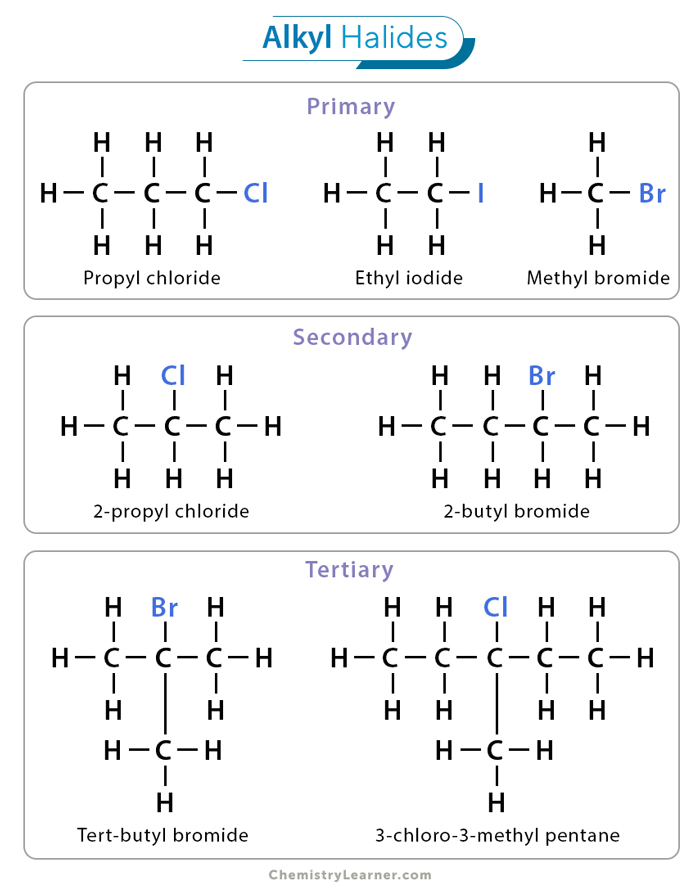Alkyl Halides
Alkyl halides or haloalkanes are hydrocarbons that incorporate halogen elements (fluorine, chlorine, bromine, or iodine) into their molecular structure. The halogen atom attaches to a carbon atom of an alkyl group. These compounds exhibit distinct chemical properties owing to the electronegativity difference between carbon and halogen atoms. They are essential in various chemical processes, from pharmaceutical synthesis to industrial applications. [1-4]
Types
Alkyl halides are classified based on the type of carbon-halogen bond present in their structure. [1-3,5,8]
Primary or 1° Alkyl Halides
They feature a halogen atom bonded to a primary carbon attached to one alkyl group. Examples include ethyl bromide (CH3CH2Br) and propyl chloride (CH3CH2CH2Cl). Although not attached to any alkyl group, methyl halide is considered a primary alkyl halide. For example, methyl bromide (CH3Br).
Secondary or 2° Alkyl Halides
They involve halogens bonded to secondary carbons, which are joined to two alkyl groups. Examples include isopropyl bromide (CH3CHBrCH3) and 2-chlorobutane (CH3CHClCH2CH3).
Tertiary or 3° Alkyl Halides
They contain halogens bonded to tertiary carbons connected to three alkyl groups. Examples include tert-butyl bromide ((CH3)3CBr) and 3-chloro-3-methyl pentane (CH3CH2C(CH3)ClCH2CH3).
Properties [1]
1. Boiling Point
Haloalkanes possess higher boiling points than alkanes with an equivalent number of carbon atoms. The main reason for this physical characteristic is London dispersion forces. It has been found that London dispersion forces are proportional to the molecular surface area. Replacing a hydrogen atom with a halogen increases the surface area. This augmented surface area subsequently increases London dispersion forces, resulting in elevated boiling points.
Another force contributing to the increased boiling points is dipole-dipole interaction. This interaction arises from the Coulombic attraction between the partially positive and partially negative charges present within the carbon-halogen bonds of each haloalkane molecule. The dipole-dipole interaction leads to stronger intermolecular forces and higher boiling points in haloalkanes compared to alkanes possessing an equivalent count of carbon atoms.
2. Solubility
Haloalkanes exhibit limited solubility in water. In order to facilitate the dissolution of haloalkanes in water, energy must be applied to counteract the attraction between the haloalkane molecules and rupture the hydrogen bond in water molecules.
The formation of new bonds between haloalkanes and water molecules generates a relatively minimal energy release, which is comparatively weaker than the original hydrogen bonds within water. Consequently, the solubility of haloalkanes in water remains restricted.
However, haloalkanes will dissolve more readily in organic solvents than in water. This tendency arises from the complex interaction between haloalkanes and organic molecules, which exhibits comparable potential to that disturbed by unique molecular haloalkanes.
Synthesis
The synthesis of alkyl halides encompasses various methods, which are discussed below. [3,6,7]
1. Alkanes react with halogens in the presence of heat or light, a process known as radical halogenation, to produce alkyl halides.
Example
Methane (CH4) reacts with bromine (Br2) in the presence of ultraviolet light, forming methyl bromide (CH3Br) and hydrobromic acid (HBr). Here, one of the hydrogen atoms from the methane is replaced by a bromine atom.
CH4 + Br2 → CH3Br + HBr
2. The reaction between alkenes and hydrogen halides yields haloalkanes. Adding HX to an alkene follows Markovnikov’s rule. The halogen will add to the more substituted side of the alkene.
Example
Propene (CH3CH=CH2) reacts with hydrogen bromide (HBr) in the presence of ultraviolet light, forming 2-bromopropane (CH3CHBrCH3), a secondary alkyl halide.
CH3CH=CH2 + HBr → CH3CHBrCH3
3. Nucleophilic substitution reactions can be initiated using alcohols as starting materials, with a halogen acid as a reactant. The result is a haloalkane.
Example
Ethanol (CH3CH2OH) reacts with hydrogen bromide to produce ethyl bromide (CH3CH2Br). The mixture is warmed to distill off the haloalkane.
CH3CH2OH + HBr → CH3CH2Br + H2O.
Reactivity and Chemical Reactions
Alkyl halides participate in a wide range of chemical reactions. Their structure heavily influences their stability and reactivity. [3,4,6,8]
1. Nucleophilic Substitution Reactions
These reactions are prevalent when a nucleophile displaces the halogen atom. Primary alkyl halides are more prone to undergo nucleophilic substitution reactions due to the less hindered nature of their carbon centers.
Example
Butyl bromide (CH3CH2CH2CH2Br) reacts with potassium cyanide (KCN) in the presence of alcohol to give butyl cyanide (CH3CH2CH2CH2CN).
CH3CH2CH2CH2Br + KCN → CH3CH2CH2CH2CN + KBr
2. Elimination Reactions
These reactions involve the removal of a halogen and a hydrogen atom to form a double bond in the presence of a strong base. Secondary alkyl halides balance reactivity and steric hindrance, making them versatile in substitution and elimination reactions. Tertiary alkyl halides, characterized by substantial steric hindrance, predominantly undergo elimination reactions to yield alkenes.
Example
Ethyl chloride (CH3CH2Cl) reacts with a strong base to form ethene (CH2=CH2) with the loss of a molecule of hydrochloric acid (HCl).
CH3CH2Cl + Strong Base → CH2=CH2 + HCl
3. Reaction with Metals
The interaction of organic chlorides, bromides, and iodides with specific metals leads to compounds encompassing bonds between carbon and metals. These compounds are referred to as organometallic compounds. For example, Grignard reagents are formed by combining haloalkanes with magnesium metal within a dry ether medium.
CH3CH2Br + Mg → CH3CH2MgBr





